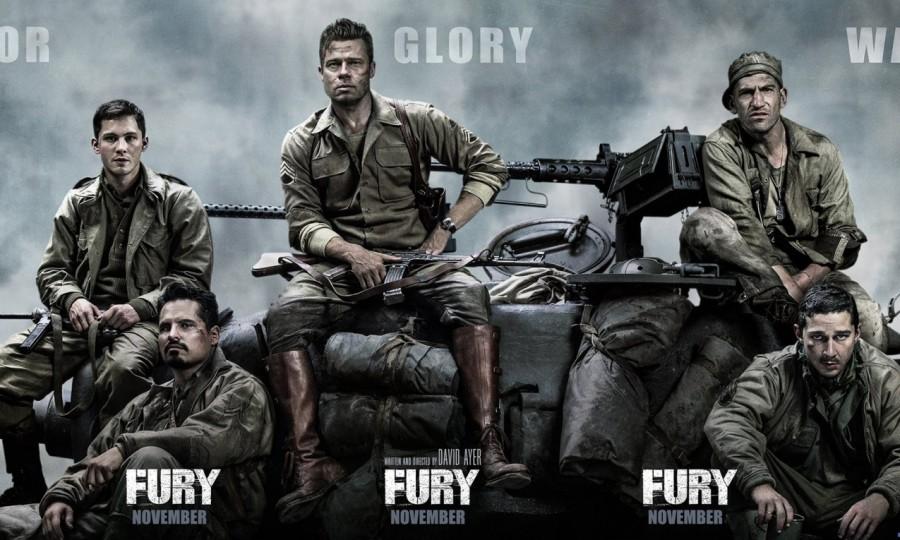Film Review: “Fury”
November 2, 2014
“Best job I ever had.”
Ringing through David Ayer’s bloody yet poignant film, this sentence captures the essence of “Fury” in five simple words.
“Best job I ever had.”
The star-studded cast of Brad Pitt as Don “Wardaddy” Collier, Shia LaBeouf as Boyd “Bible” Swan, Logan Lerman as Norman “Machine” Ellison, Michael Peña as Trini “Gordo” Garcia and Jon Bernthal as Grady “Coon-Ass” Travis bring to life the story of a tank named “Fury” in Germany as the country, and the world, are being torn apart by the war.
The movie, released Oct. 17, begins not with a visual aspect, but with sounds: radio static, military commands and distant artillery fire frame the opening shot of a lone horseman, and from the instant that horse and rider appeared on screen, I was immersed. The combination of the sound design and the cinematography in “Fury” were outstanding.
While the film had grand, sweeping shots as one would expect from a movie as epic as this one, the minimalistic aspects of them were really what shook me to the core. The sight of just Sergeant Collier’s hands as he climbed out of the tank that carried his dead crewman, the gloved fingers framing the word “Fury” on the main gun, or of Private Ellison lying on the ground and trying to collect himself, a young boy caught in a war he didn’t fully understand were far more visually striking than the grandiose maneuvers. By keeping the wide shots to a minimum, Ayer played up his actors’ skills.
When it comes to the actors, the cast truly did drive the film. While “Fury” might be set in the war, the movie is about so much more than that.
Pitt, playing the gruff leader of his tank played up to all the expectations I had of him going into the film. As a big fan of his work in movies like “Fight Club,” “Moneyball” and “Inglourious Bastards” where he was extremely outward with his emotions, watching him play with subtlety and actually enjoying it was refreshing.
LaBeouf, famous for his time on Disney Channel and for his work in the “Transformers” franchise, had never been a name that crossed my mind when I thought of actors who were truly amazing. In this role, however, LaBeouf exceeded my expectations. As the man most deeply conflicted about his faith, LaBeouf portrayed that inner conflict with finesse, making me forget all about his time spent on “Even Stevens.”
I was unsure when it came to Peña’s performance. I had never really known his work before “Fury,” and I wasn’t totally impressed by what he did. He was good, yes, but the other actors shone so brightly that it drowned out Peña’s acting, and while he fit right in with the rest of the cast, there was nothing that I found truly spectacular about his role.
Bernthal’s name was another that I hadn’t heard before seeing “Fury,” and while I won’t be hunting down movies that he has starred in, I thought he was phenomenal. Grady Travis could be a really slimy character: the way he acted around women or the way he treated dead German soldiers was detestable. It takes a lot for an actor to portray someone like that, and I admired the full throttle way that Bernthal simply went after it. What’s even better is that Travis proved to be a more nuanced person, and Bernthal’s performance captured the character exactly the way I think the writers would have intended it.
The real standout of the cast, however, was Lerman as Ellison. Coming from films like “Percy Jackson: Sea of Monsters” and “The Perks of Being a Wallflower,” movies primarily directed at young adults, Lerman really proved his mettle this time, showing that he can and he will play ball in the big leagues. Ellison came to life on screen, and when the movie ended I had to remind myself that he wasn’t a real person. Lerman’s attention to detail in his performance created not just a character but a person, and that, to me, is the most impressive thing that an actor can do.
The cast would have been nothing, however, without the screenplay that blew me away. While I might have done without some of the more grotesque scenes, the dialogue they wrote was fantastic.
There are a few lines that really struck me throughout the movie, and while saying them here would be spoiling the film for those who want to see it, I can honestly say that they are still resonating with me. There were moments, silent moments with nothing but the voice of the actor speaking, that I felt chills go down my spine and I had to lean forward and give the movie even more than my full attention. The dialogue was spot on and breathed life into the characters just as much as the characters breathed life into them. Every single word that was spoken gave the character a new depth, and added to the effect that the movie wasn’t just about war, but about so much more.
The writers added in strong parallels with the historical events surrounding the movie’s premise, lending a strong realness to the film. The underpinnings of religion were evident with every character, whether it was Garcia crossing himself as they went into battle, or Ellison mouthing the words to a Bible verse that Swan was telling the men in the tank as they faced the impossible.
Considering the horrors that went on in World War II, specifically related to faith and religion, having characters that had strong ties to their own faith paralleled historical events in a way that made “Fury” feel like it should be a part of the history books. It gave the movie resonance in quiet scenes where Steven Price chose not to write one of his intense scores, instead letting the emotions that the actors displayed be enough that he didn’t need to fill it in with music.
Price, fresh off an Oscar for his work on “Gravity,” created yet another Oscar-worthy score. The music was scant throughout the film, however, in the moments when it really mattered, Price delivered with a deep and ominous male choir backed by intense strings, highlighting the battle scenes and adding tension to moments that would have already had me falling out of my seat.
Price also kept it simple when it needed to give a little. In the most powerful and moving parts of the film, I found that the music, instead of being distracting and forcing me to listen to it, my point of contention with a lot of film scores, I found that a light piano melody calmed everything down and shone a spotlight on the raw emotion in the scenes.
While everything I have said has framed “Fury” to be spectacular, I did find some faults with the film.
The gratuitous violence was to be expected of a war film. I feel that Ayer, in trying to be realistic, however, proved to be too bloody and too violent. While watching the film, I was enjoying it except for the jarring moments when someone’s head would be blown off or a man would catch fire. I expected there to be a lot of violence, but I didn’t go into the film looking to see pieces of flesh seared to the inside of the tank. I almost couldn’t sit through it at some points, the blood and gore proving to be far too much for me to watch.
Also, the ending was far too unsatisfying for my taste. While the entire film had a feel similar to Ridley Scott’s 1998 film “Saving Private Ryan,” the ending of “Fury” left me wanting much more. It was Ayer’s artistic choice, yes, but going into a war film, I’d much rather have Private Ryan saluting his captain’s grave rather than what Ayer gave me. It felt a little bit too much like there should be more to the movie: the story felt incomplete.
I suppose, however, the ending speaks to the realities of war. Stories get interrupted and cut off. People are snuffed out like candles. In both the world wars, the global community lost entire generations of young men. The casualties piled so high that it was impossible to account for everyone lost. The half-finished story filled Ayer’s purpose, and having the film go out with a bang rather than a sizzle worked in his favor.
It’s like the tagline on the movie posters said: “War never ends quietly.”
Fury is rated R for strong sequences of war violence, some grisly images, and language. It’s running time is 134 minutes.









Jeremiah Agware • Dec 6, 2021 at 9:42 am
I do spend most of my free time watching movies and TV series. It’s almost like I don’t have a life after work and movies ??? I agree with you on this and keep up the good work.